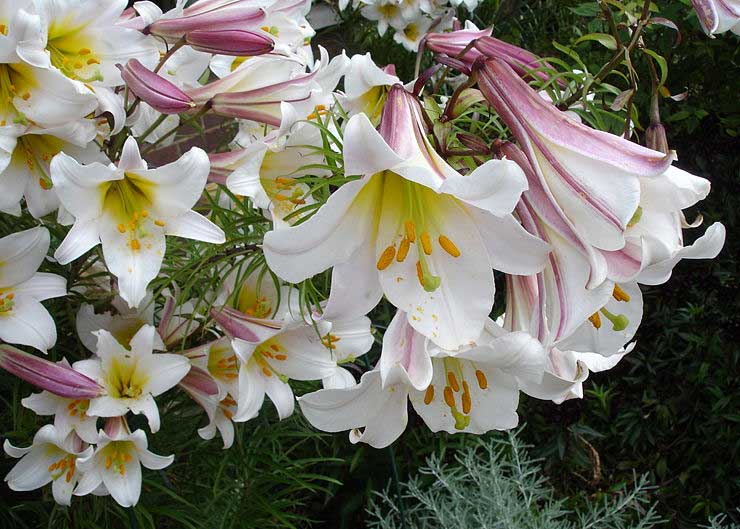
Lilium regale (*)
Classification System: APG IV
Superregnum: Eukaryota
Regnum: Plantae
Cladus: Angiosperms
Cladus: Monocots
Ordo: Liliales
Familia: Liliaceae
Subfamilia: Lilioideae
Genus: Lilium
Sectio: L. sect. Regalia
Species: Lilium regale
Name
Lilium regale E.H.Wilson (1913)
Synonyms
Heterotypic
Lilium myriophyllum E.H.Wilson, Flora et Silva 3: 330, pl. 1. 1905.
Hybrids
Lilium × centigale Woodcock & Coutts
Lilium × imperiale E.H.Wilson
Lilium × sulphurgale A.Perry
References
Wilson, E.H. 1913. Gard. Chron., III, 53: 416.
Vernacular names
Deutsch: Königs-Lilie
suomi: Kuningaslilja
svenska: Kungslilja
Lilium regale, called the regal lily,[3] royal lily,[4] king's lily,[5] or, in New Zealand, the Christmas lily,[6][7] is a species of flowering plant in the lily family Liliaceae, with trumpet-shaped flowers. It is native to the western part of Sichuan Province in southwestern China,[8][1] and cultivated elsewhere as an ornamental. It was introduced to England in 1903 by Ernest Henry Wilson.[9][10]
Description
Lilium regale is a long-lived, stem-rooting herbaceous perennial growing from an underground bulb. The leaves are borne at irregular intervals on the stem. Plants grow up to 2 meters high, though 1.2 to 1.5 meters is more common in the garden. The flowers are 14 cm long, funnel or trumpet shaped, white with yellow throat, flushed purple outside. Stamens are prominent. The flowers are strongly fragrant, especially at night.[1]
Cultivation
The Royal Horticultural Society has given Lilium regale its Award of Garden Merit.[11] It is among the easiest lilies to grow in most temperate climate gardens. It tolerates most soils, except ones prone to waterlogging. It may naturalise in suitable conditions. It can also be grown in large containers. The bulbs themselves are very hardy, but the shoots appear early in the season and may be damaged by frost. Plants can be raised from seed, and often flower in their second year. A serious pest is the Scarlet Lily Beetle, the larvae of which may cause complete defoliation. Stems may require staking to support the large blooms.[5][12]
There is a pure white form 'Album' which is also widely cultivated.[13]
Deer also frequently eat lily plants and fences as high as 8 feet may be needed to deter them.[14]
Toxicity
Cats
Lilium regale, like many in the genus, is toxic to cats, with ingestion causing potentially fatal renal failure.[15] Households that are visited by cats are advised against keeping this plant or placing dried flowers where a cat may brush against them and thus become dusted with pollen, which is then consumed during cleaning. Suspected cases require urgent veterinary attention.[16] Rapid treatment with activated charcoal and/or induced vomiting can reduce the amount of toxin absorbed, and large amounts of fluid by IV can reduce damage to kidneys to increase the chances of survival.[16]
References
Flora of China, Vol. 24 Page 147 岷江百合 min jiang bai he Lilium regale E. H. Wilson, Gard. Chron. ser. 3, 53: 416. 1913.
Tropicos, search for Lilium myriophyllum
"Lilium regale". Natural Resources Conservation Service PLANTS Database. USDA. Retrieved 25 January 2016.
BSBI List 2007 (xls). Botanical Society of Britain and Ireland. Archived from the original (xls) on 2015-06-26. Retrieved 2014-10-17.
Royal Horticultural Society, Lilium regale (IXb/a) king's lily
Carman, Kerry (2015-11-06). "How to grow... madonna lilies". Stuff.co.nz. Retrieved 2018-12-16.
"Lily Regale". Kings Seeds. Retrieved 2018-12-16.
Kew World Checklist of Selected Plant Families
Wilson, Ernest Henry 1905. Flora et Silva 3: 330, plate 1, as Lilium myriophyllum
Wilson, Ernest Henry. 1913. Lilium regale. Gardeners' Chronicle: a weekly illustrated journal of horticulture and allied subjects. ser. 3 53: 416 description and commentary in English; photograph of flowering specimen
"RHS Plant Selector - Lilium regale". Retrieved 16 January 2021.
Dave's Garden plant files, Regal Lily, Lilium regale
"Lilium regale 'Album'". Gardenia.net. Retrieved 3 July 2021.
"Will Deer Eat Hostas & Lilies?". SFGate. Hearst. Retrieved 2019-11-27.
Fitzgerald, K.T. (2010). "Lily toxicity in the cat". Topics in Companion Animal Medicine. 25 (4): 213–217. doi:10.1053/j.tcam.2010.09.006. PMID 21147474.
Lily Poisoning in Cats. Pet MD.
Retrieved from "http://en.wikipedia.org/"
All text is available under the terms of the GNU Free Documentation License

